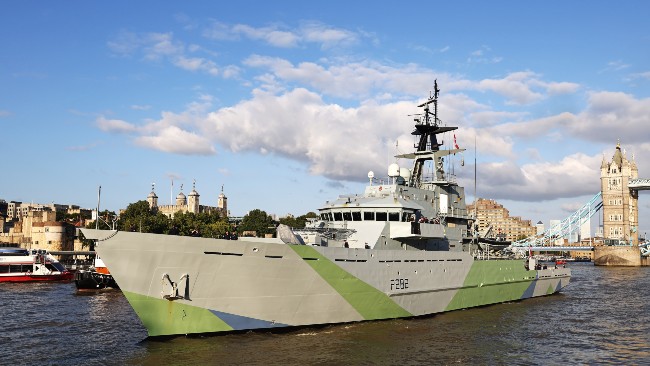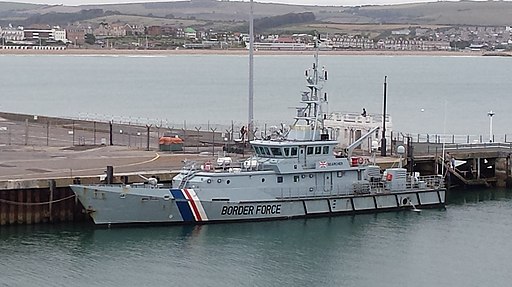Time to make it count: Implementing the UK’s new maritime security strategy

In 2022, the UK government will launch a new National Strategy for Maritime Security (NSMS). The publication of the NSMS comes at a critical time. Maritime threats and risks to the UK continue to evolve and multiply, in home waters and beyond.
Brexit has focused new attention on the demands of policing UK waters outside the EU. New foreign policy priorities such as the ‘Indo-Pacific tilt’ gravitate around maritime challenges. Recognition is growing that climate change, over-exploitation and biodiversity loss will pose new risks to the oceans and UK maritime interests.
Maritime strategy makers do not have an easy task. They must deal with a diverse range of threats and risks. They must work across multiple different departments, agencies, and actors. And they must deal with what are often fundamentally transnational challenges, not easily constrained by or bound within the territorial borders of states.
On 9 June 2022, the University of Bristol and SafeSeas held an IdeasLab in Bristol to reflect on lessons learned from the 2022 NSMS process. The event took place in collaboration with the UK Department for Transport (DfT)and Joint Maritime Security Centre (JMSC). Participants from all major UK maritime security agencies attended, as did academics representing disciplines ranging from international law to security studies.
This Policy Report summarises the findings of the IdeasLab and outlines key policy implications for UK government and other maritime stakeholders.
Research findings
• The 2022 NSMS refreshes and updates the UK’s first maritime security strategy of 2014. The 2014 strategy was an important and internationally influential document. However, it struggled to secure cross-departmental buy-in within government. The geopolitical and maritime security threat environment has also changed significantly since 2014. UK maritime security structures have matured in this time, particularly in consequence of the Brexit process.
• The NSMS outlines a range of different threats and risks to UK maritime security. These include inter-state disputes at sea, the threat of maritime terrorism or cyber-attacks, people smuggling and the trafficking of illicit goods by sea, piracy, illegal fishing, marine environmental protection, and the protection of critical infrastructure. These threats are often transnational in nature, can interconnect with each other in important ways, and engender multi-agency and cross-national responses. The role of the strategy in this context is to prioritise and order he UK’s response to these issues, across different threats, agencies, and geographic spaces over the five-year period to 2027.
• The 2022 NSMS consolidates the UK maritime security response. It articulates changing maritime threat priorities, recognises the new foreign policy priorities set out in the government’s Integrated Review of 2021, and strengthens the new cross-governmental maritime security structures that the UK has developed since 2014. This ‘whole system approach’ establishes a cross-departmental governance and review structure for maritime security issues. It also embeds the role of the multi-agency JMSC at the heart of UK maritime response, as the body responsible for understanding threats in the maritime environment and coordinating UK government responses to them.
• The NSMS identifies geopolitical challenges and environmental security at sea as new priorities. Both issues were marginal in the 2014 strategy, and both will require hard choices about how finite resources should be allocated between issues and regions. The return of geopolitics to UK maritime security thinking will mean balancing between UK interests in the immediate European and North Atlantic maritime regions, and those of global scope in the Indo-Pacific and elsewhere. New environmental priorities will require policing and enforcement at sea, as well as long term planning and investment if the effects of climate change in the marine environment are to be allayed.
• While the UK approach to maritime security envisages an integrated response, coordination challenges between departments and agencies remain. It is notable in this respect that the 2022 NSMS was the product of a collaborative writing process, led by the DfT. The 27 sections of the document were produced by over 50 specialists from different UK maritime security stakeholders, and with external input from academia and industry. This approach provided an opportunity to negotiate a common strategic narrative, set of priorities and coordination structure. The longevity and success of the NSMS is likely to be dependent on the extent to which this process has been able to achieve cross-departmental buy-in to goals and provisions of the strategy.
• As the NSMS recognises, maritime security is not just about what happens at sea. For this reason, the success of the UK maritime security response will be linked to and interdependent with other areas of policy too, for example on serious organised crime, on refugees and asylum seekers, and on development initiatives with partners in the Global South. It is important that these interconnections and synergies between policy areas are recognised and understood, and that measures to police maritime insecurities at sea are accompanied by efforts to address their root causes on land as well.
• Implementing the NSMS is more than just a technical endeavour. Political commitment will be necessary to ensure that the goals of the strategy are maintained in practice and over time, especially in relation to marine environmental protection. Sufficient resources will need to be allocated for the structures and mechanisms established by the strategy to endure and mature. Stakeholder relationships and habits of joint working will need to be nurtured and strengthened at both policy and operational levels if it the ‘whole system approach’ to maritime security is to be sustained.

Policy implications
• It is critical that the NSMS is understood as one part of an ongoing process of UK maritime security governance rather than an end point in and of itself. It will require work to ensure that the strategy remains a ‘live’ document over its five-year lifespan.
• Government should ensure it has the capacity to anticipate and adapt to new threats or strategic shocks in the maritime environment. It should work to strengthen its knowledge base on maritime risks and threats and foster the strategic policy-making communities that can fashion agile responses to change.
• It is important that the expertise, relationships, and institutional memories developed during the NSMS process are retained beyond the publication of the strategy itself. These should be embedded through strategy implementation, review, and reporting processes, but also through ongoing cross-departmental threat analysis and horizon scanning work.
• Government should ensure that ‘whole system approach’ established by the strategy is consolidated through operational-level collaboration, information sharing and joint working across agencies. Initiatives such as staff placements and joint exercises should be encouraged to build habits of cooperation between agencies.
• Government should establish the resilience of its maritime security architectures by ensuring consistent and predicable funding and staffing cycles for agencies such as the JMSC, and by working to sustain cross-departmental buy-in to the goals and provisions of the strategy.
• Government should conduct a thorough assessment of how climate change will impact on UK maritime security threats, responses, and infrastructures with an eye on long-term preparedness and resilience.
• Government should undertake a review of its evidence base on maritime security threats and risks and initiate further ‘deep dive’ research where knowledge gaps are identified. Such work should focus on the root causes of maritime insecurities and how best to respond to them at source.
• The 2022 NSMS confirms the UK as a world leader in maritime security governance. The UK Government should make the most of the opportunity this presents to steer and influence the global debate on maritime security. It can do so through capacity building initiatives with partner states, and through diplomatic leadership in regional maritime security arrangements and global bodies such as the UN Security Council.

Further information
Further information on the IdeasLab and the SafeSeas Network can be found at www.safeseas.net and on our Twitter feed @safeseas1
Find out more about SafeSeas’ work on UK maritime security here: https://www.safeseas.net/themes/maritime-security-after-brexit
Author
Professor Timothy Edmunds (University of Bristol/SafeSeas)
Policy Report 71: July 2021
Time to make it count: Implementing the UK’s new maritime security strategy (PDF, 906kB)